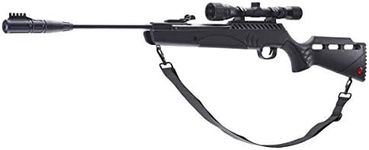Buying Guide for the Best Pellet Rifles
Choosing the right pellet rifle can be a rewarding experience, whether you're looking for a tool for pest control, target shooting, or small game hunting. The key to finding the best fit for you is understanding the various specifications and how they align with your needs. By focusing on the right specs, you can ensure that your pellet rifle will perform as expected and provide you with the best experience possible.CaliberCaliber refers to the diameter of the pellets that the rifle uses. The most common calibers are .177, .20, .22, and .25. The .177 caliber is popular for target shooting and small pest control due to its high velocity and flat trajectory. The .22 caliber is preferred for small game hunting because it delivers more impact energy. The .20 and .25 calibers offer a balance between the two. Choose a caliber based on your primary use: .177 for precision and speed, .22 for power and impact, and .20 or .25 for a mix of both.
VelocityVelocity is the speed at which the pellet leaves the barrel, measured in feet per second (fps). Higher velocity means a flatter trajectory and potentially more accuracy at longer distances. Pellet rifles typically range from 500 fps to over 1200 fps. For target shooting, a velocity of 600-800 fps is usually sufficient. For hunting, higher velocities (800-1200 fps) are preferred to ensure the pellet has enough power to humanely take down small game. Consider your intended use to determine the appropriate velocity.
Power SourcePellet rifles can be powered by different mechanisms: spring-piston, gas piston, CO2, and pre-charged pneumatic (PCP). Spring-piston and gas piston rifles are popular for their simplicity and reliability, with gas piston models offering smoother cocking and shooting. CO2 rifles are easy to use and provide consistent power but require CO2 cartridges. PCP rifles offer the highest power and accuracy but are more complex and require a separate air source for refilling. Choose a power source based on your preference for ease of use, power, and maintenance.
AccuracyAccuracy is crucial for both target shooting and hunting. Factors that affect accuracy include the quality of the barrel, the consistency of the power source, and the type of pellets used. Rifles with rifled barrels tend to be more accurate than those with smoothbore barrels. Consistent power sources like PCP and gas piston can also enhance accuracy. Additionally, using high-quality, well-matched pellets can improve performance. Consider investing in a rifle with a good reputation for accuracy if precision is important to you.
Weight and ErgonomicsThe weight and ergonomics of a pellet rifle affect how comfortable it is to handle and shoot. Heavier rifles can be more stable and absorb recoil better, but they may be tiring to carry and use for extended periods. Lighter rifles are easier to maneuver and carry but may be less stable. Ergonomics, including the design of the stock and grip, also play a role in comfort. Try handling different rifles to see which feels best in your hands and consider how you'll be using the rifle to determine the ideal weight and ergonomics for you.
Noise LevelThe noise level of a pellet rifle can be an important consideration, especially if you plan to use it in a residential area or for hunting. Some rifles are designed to be quieter, using built-in suppressors or shrouded barrels to reduce noise. Spring-piston and gas piston rifles tend to be louder than CO2 and PCP models. If noise is a concern, look for rifles specifically marketed as quiet or with noise-dampening features. Consider your environment and how important noise reduction is for your intended use.






















